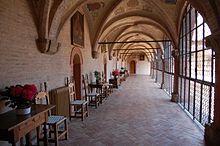Collegio di Spagna
King Alfonso participated in the unveiling of a tablet recording the visit of the royal couple and another one noting the name of two famous former students of the College, Ignatius of Loyola and Miguel de Cervantes.[3] The architecture of the Collegio is peculiarly Italian in the use of the loggia, but shares a characteristic of medieval college buildings in England and France, in being arranged around a central rectangular court.From this circumstance we may regard the picture as a series of authentic portraits, in the precise costume of the period.The book also mentions artwork in the chapel: "some frescoes by C. Procaccini and a Sta.The Jury admired the beauty and detail of this meticulous restoration, especially of the frescoes, and the courage and determination shown in sustaining both momentum and funding over such a long period.The magnitude of the historical research, as well as the scope of the works and the absence of external subsidies must be taken into account when considering the 32-year-long restoration, during which the most difficult task was the financial restructuring of the foundation’s heritage.”[9]









collegeSpanishUniversity of BolognaInnocent VIIIGil Álvarez Carrillo de AlbornozUniversity of SalamancaThe TimesQueen of SpainIgnatius of LoyolaMiguel de CervantesPaolo MontiCharles VloggiaBas reliefsAnnibale CarracciBartolommeo BagnacavalloClement VIICamillo ProcacciniMarco ZoppoGoogle BooksA History of the University in Europe: Volume 1, Universities in the Middle AgesCambridge University PressGieysztor, AlexanderGrove Art OnlineOxford University PressA. Gieysztor